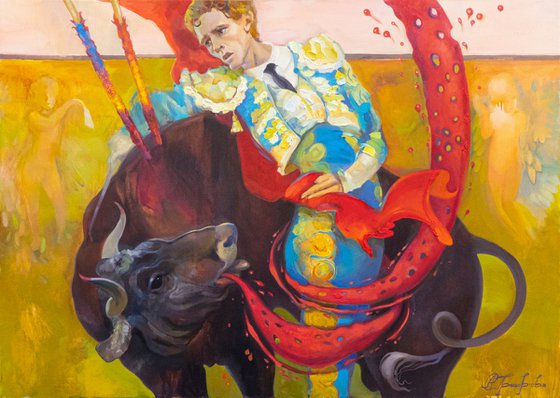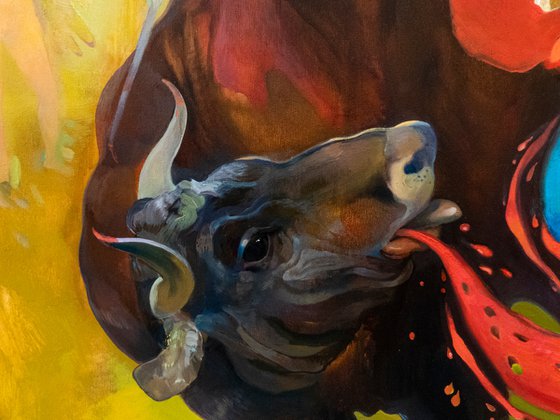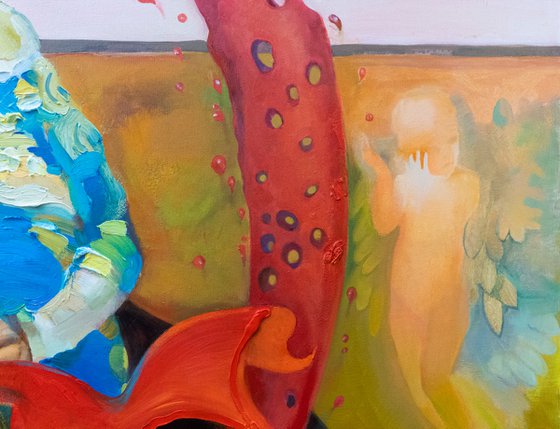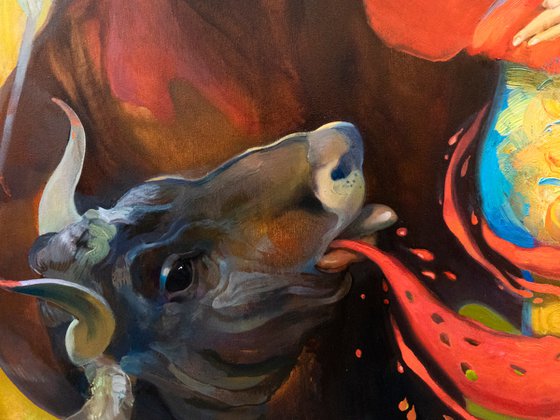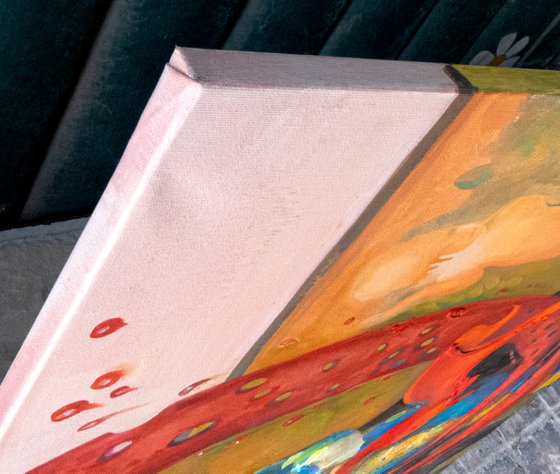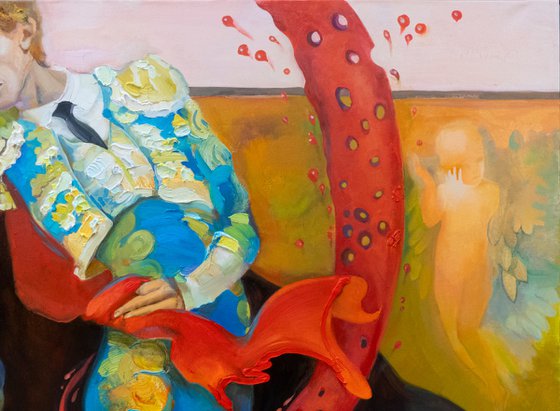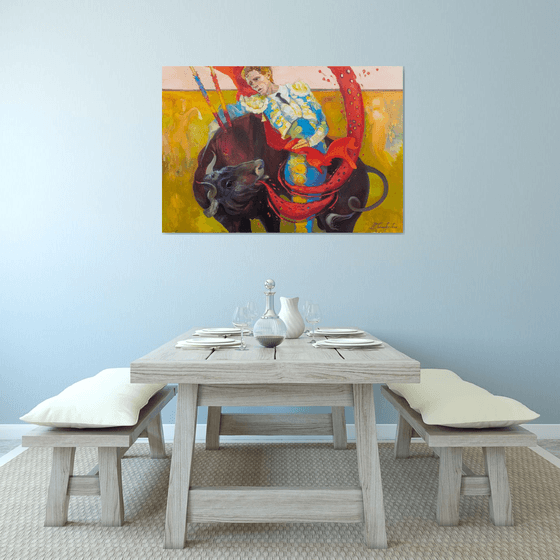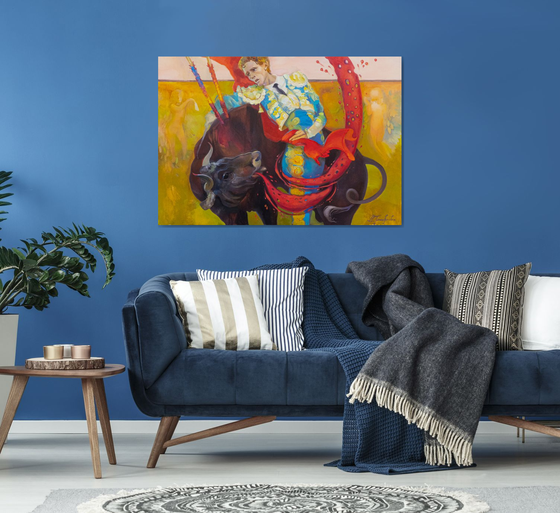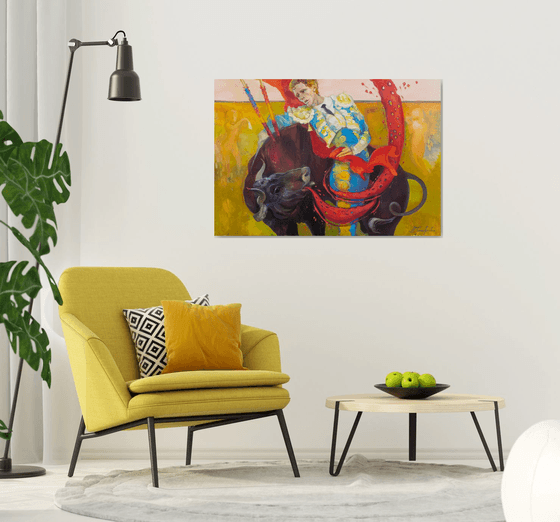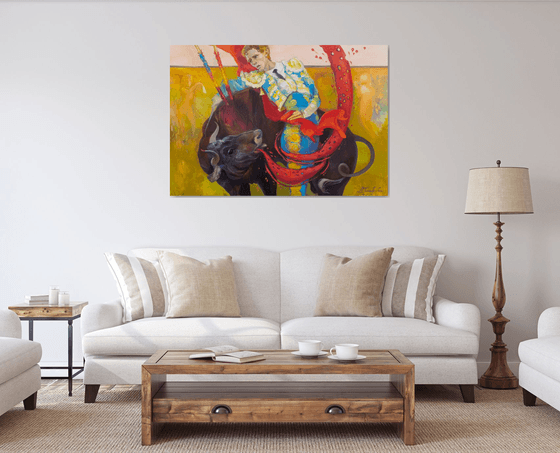- By medium
- By subject
- By budget
- Sales
- Gift cards
- Discover all art
- Artists
- Editors’ picks
- Ideas
Original artwork description:
The corrida is a spectacular element of Spanish culture that impresses with its grandeur and drama. However, in my painting titled "Die, for I am dying," I aimed to convey the complex emotions that arose in me while observing this event.
The canvas depicts a young matador named Borja Jimenez at the moment of killing a bull named Cuba. This climax of the corrida, where the life of the animal ends in front of thousands of spectators, evoked mixed emotions in me.
Spanish culture is striking in its diversity. I wanted to understand why, in the 21st century, the art of the corrida still exists with its bloodshed. Is it the torment of an animal for human entertainment, or a cultural sacrifice? Talking with Spaniards, I found that their opinions were divided. Most people I spoke to had a negative attitude towards the corrida due to the presence of animal and sometimes matador killings. However, there are those who consider the corrida an art and attend it with respect for tradition.
I decided to personally attend a corrida. The first thing that struck me was the disorientation of the animal released into the arena. At first, the bull seems friendly, but then the matadors and picadors begin to wound it to provoke aggression and then kill it because an aggressive bull will no longer be normal. This reminded me of the situation in Ukraine, where we are the victims released into the arena, and the spectators are the global community watching the events.
The entire corrida, from the release of the animal to its killing, lasts about 20 minutes. Overall, at this event, I witnessed the deaths of six bulls. After the third bull, named Cuba, I wanted to leave but returned, hoping to understand the spectators and their attachment to this spectacle. I tried to connect with the crowd that takes pleasure in the corrida and felt some satisfaction.
However, ultimately, I imagined myself in the place of the bull, feeling its fear and pain, trying to understand what the torero feels, playing with death in front of an enthusiastic audience.
During the show, I met a Spanish woman who regularly attends corridas. She asked me if I liked the spectacle. Her eyes were full of expression, and I couldn't give a definite answer. She then asked differently, whether I would come again, and I said no.
My painting is an attempt to convey the inner conflict I felt during the corrida. It challenges my understanding of art, traditions, and human cruelty.
- size 89x130cm/ 35.03х51.18inch
- year 2024.
- materials: oil paints, canvas.
- ready to hang.
- edges of a picture is painted.
- certificate of authenticity is included.
- shipping in TUBE without wood streatcher.
Materials used:
oil on canvas
Tags:
#bull #matador #blood #toreador #corrida de #bullfighter #tauromaquia #toreador painting #matador and #torero scene #valencia spain #korrida #coliseo for #toreo #borja jimenezDie, for I am dying (2024) Oil painting
by Anastasiia Grygorieva
26 Artist Reviews
£5,012.63
- Oil painting on Canvas
- One of a kind artwork
- Size: 130 x 90 x 2cm (unframed)
- Signed on the front
- Style: Impressionistic
- Subject: People and portraits
Loading
Original artwork description
The corrida is a spectacular element of Spanish culture that impresses with its grandeur and drama. However, in my painting titled "Die, for I am dying," I aimed to convey the complex emotions that arose in me while observing this event.
The canvas depicts a young matador named Borja Jimenez at the moment of killing a bull named Cuba. This climax of the corrida, where the life of the animal ends in front of thousands of spectators, evoked mixed emotions in me.
Spanish culture is striking in its diversity. I wanted to understand why, in the 21st century, the art of the corrida still exists with its bloodshed. Is it the torment of an animal for human entertainment, or a cultural sacrifice? Talking with Spaniards, I found that their opinions were divided. Most people I spoke to had a negative attitude towards the corrida due to the presence of animal and sometimes matador killings. However, there are those who consider the corrida an art and attend it with respect for tradition.
I decided to personally attend a corrida. The first thing that struck me was the disorientation of the animal released into the arena. At first, the bull seems friendly, but then the matadors and picadors begin to wound it to provoke aggression and then kill it because an aggressive bull will no longer be normal. This reminded me of the situation in Ukraine, where we are the victims released into the arena, and the spectators are the global community watching the events.
The entire corrida, from the release of the animal to its killing, lasts about 20 minutes. Overall, at this event, I witnessed the deaths of six bulls. After the third bull, named Cuba, I wanted to leave but returned, hoping to understand the spectators and their attachment to this spectacle. I tried to connect with the crowd that takes pleasure in the corrida and felt some satisfaction.
However, ultimately, I imagined myself in the place of the bull, feeling its fear and pain, trying to understand what the torero feels, playing with death in front of an enthusiastic audience.
During the show, I met a Spanish woman who regularly attends corridas. She asked me if I liked the spectacle. Her eyes were full of expression, and I couldn't give a definite answer. She then asked differently, whether I would come again, and I said no.
My painting is an attempt to convey the inner conflict I felt during the corrida. It challenges my understanding of art, traditions, and human cruelty.
- size 89x130cm/ 35.03х51.18inch
- year 2024.
- materials: oil paints, canvas.
- ready to hang.
- edges of a picture is painted.
- certificate of authenticity is included.
- shipping in TUBE without wood streatcher.
Materials used:
oil on canvas
Tags:
#bull #matador #blood #toreador #corrida de #bullfighter #tauromaquia #toreador painting #matador and #torero scene #valencia spain #korrida #coliseo for #toreo #borja jimenez14 day money back guaranteeLearn more
